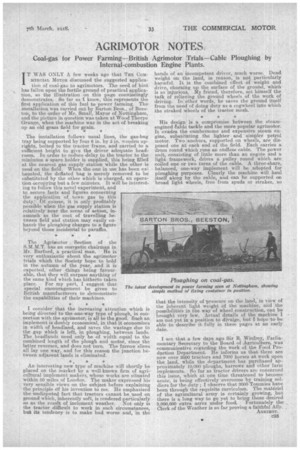AGRIMOTOR NOTES.
Page 13

If you've noticed an error in this article please click here to report it so we can fix it.
Coal-gas for Power Farming—British Agrimotor Trials—Cable Ploughing by Internal-combustion Engine Plants.
I12 WAS ONLY A few weeks ago that THE COMMERCIAL MOTOR discussed the suggested application of coal-gas to agrimotors. The seed of hint has fallen upon the fertile ground of practical application, as the illustration on this. page convincingly demonstrates. So far as i know, this represents the first application of this fuel to power farming. The installation was carried out by Barton Bros., of Beeston, to the order of Mr. Small, Mayor of Nottingham, and the picture in question was taken at Wood Thorpe Grange, when the machine was in the act of breaking up an old gram field for grain.
The installation follows usual lines, the gas-bag tray being supported, by four 6 in. by 2 in. wooden uprights, bolted to the tractor frame, and carried to a sufficient height to give the driver adequate headroom. In order to seduce delay to the tractor to the minimiim a spare holder is supplied, this being filled at the nearest gas supply station while the other is used on the field. When the one in use has been ex= hau.sted, the deflated bag is merely removed to be substituted by the other which is charged, an operation occupying but a few minutes. It will be interesting to follow this novel experiment, and to secure facts and figures concerning — the application of town gas to this duty: Of course, it is only profitably possible when the gaz supply station is relatively near the scene of action, inasmuch as the cost of travelling between field and station may easily enhance the ploughing charges to a figure beyond those incidental to paraffin.
The Agrianotor Section of the S.M.M.T. has an energetic chairman in Mr. Burford, a practical man. He is very enthusiastic about the agrimotor trials which the Society hope to hold in the autumn of the year, and it is expected, other things being favour.. able, that they will surpass anythingof the same kind which has hitherto taken place. For my part., I suggest that special encouragement be given to British manufacturers to demonstrate the capabilities of their machines.
I consider that the increasing attention which is being directed to the one-way type of plough, in connection with the agrimotor, is all to the good. Such an implement is doubly economical, in that it economises in width of headland, and saves the wastage due te the gap which is left, in ploughing. between lands. The headlands need only be of width equal to the combined length of the plough and motor, since the latter reverses, and does not turn. The furrow slices all lay one way, and for this reason the junction between adjacent lands is eliminated.
An interesting new type of machine will shortly be placed on the market by a well-known firm of agricultural implement makers, whose works are situated within 50 miles of London. The maker expressed his very sensible views on the subject 'before explaining the principle cif his invention to me. He emphasized the undisputed fact that tractors cannot be used on ground which, inherently soft, is rendered particularly so as the rasult of inclement weather. Not only is the tractor diffieult to work in such circumstances, but its tendency is to make bad worse and, in the hands of an incompetent driver, much worse. Dead weight on the land, in reason, is net particularly harmful. It is the combined effect of weight and drive, churning up the surface of the ground, which is so injurious. My friend, therefore, set himself the taSk of relieving the ground wheels of the work of driving. In other words he saves the ground itself from the need of doing duty as a cogwheel into which the straked wheels of the tractor mesh.
His design is a compromise between the steamengined fable tackle and the morepopular agrimotor. It evades the cumbersome and expensive steam engine, substituting the lighter and simpler petrol motor. Two anchors, supported on wheels, are disposed one at each end of the field. Each carries a drum round which runs an endless cable. The power unit, consisting of little more than an engine and a light framework, drives a pulley round which are coiled one or two turns of the cable. A three-share, balanced, one-way implement will be adopted for ploughing purposes. Clearly the machine will haul itself along by the cable, and can be supported on broad light wheels, free from spuds or strakes, so that the intensity, of pressure on the land,in view of the inherent light weight of the machine, and the possibilities in the way of wheel construction,, can be brought very low. -Actual details of the machine I am not yet in a position to divulge,. -but I hope 'tobe able to describe it fully in these pages at an early date.
I see that a. few days ago Sir R. Winfrey, Parliamentary. Secretary to the Board of Agriculture, was communicative regarding the work of the Food Production Department. He informs us that there are now over 2500 tractors and 7000 horses at work upon the land, while the department has purchased approximately 1.0,000 ploughs, harrows and other farm implements. So far as tractor drivers are concerned this issue, which at one time threatened to become acute is being effectively overcome by training soldiers 'for the duty ; I observe that 3000 Tommies have been through the requisite curriculum. The materiel of the agricultural army is certainly growing, but there is a long way to go yet to brirT' those desired 3,000,000 extra acres under food. Fortunately the Clerk of the Weather is so far proving a faithful Ally. AGRIMOT. C35






















